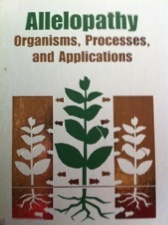Book Review






Allelopathy: Organisms, Processes, and Applications discusses the often overlooked functions of natural products as the tools they were designed to be. Chemists and Biologists commonly overlook the natural context of the natural products they study, this book focuses on elucidating the functions of these compounds as they contribute to the ecology of their environments. Specifically, Allelopathy is the study of any compounds plants produce that interact with other flora in their environments, including algae, fungi, and bacteria. For instance, the first article presented in this text deals with various secondary metabolites produced by a particular lichen which inhibit growth of other flora, including other lichens, on its particular substrate.
This book is intended for the scientifically literate, but who are not necessarily intimately familiar with Allelopathy as a subclass. Though the book discusses and explains much of the scientific content, the reader should be able to decipher JACS type publications. This book is part of a series commissioned by the Botanical Society of America section of the American Institute of Biological Sciences aimed at capturing “snapshots in time” of various areas of botanical research. The series was published by the American Chemical Society, with the goal of quick publication of quality research which has been reviewed by peers and editors and revised by their original authors prior to publication. In summary, this book is a
The contents of this material is arranged such that the first chapter gives an overview on “Allelopathy” as it is defined as well as its scope within ecology and biology. The remainder of the book consists of specific examples presented as either the original scientific publications themselves or reviews of published articles interspersed with chapters of discussions of the implications and generality of the articles' contents. Each chapter, whether review or article are fully cited, making this book a good resource as a jumping-off point for many related interests. Illustrations present within this book are typical of what you would find in JACS publications (and many of them are), and as such are largely graphs, plots, and spreadsheets, however there is the occasional sketch or flowchart as relevant to the topic at hand.
Inderjit, Dakshini, K. M. M., Einhellig, F. A. Eds. 1995. Allelopathy: Organisms, Processes, and Applications. Washington, DC: American Chemical Society.
In biology, nothing is clear, everything is too complicated, everything is a mess, and just when you think you understand something, you peel off a layer and find deeper complications beneath. Nature is anything but simple.”
― Richard Preston
Monday, January 30, 2012



Allelopathy





